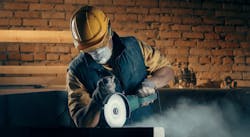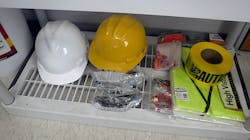Don’t Cut Corners on Construction Jobsite Safety
In my experience walking dozens of residential construction jobsites a year, I am mystified by how difficult it is to get “buy in” from individual tradespeople to use personal protective equipment (PPE) to help ensure their safety. I believe most of the production builders we work with, as well as their trade partners who sub out the actual work, feel the same.
Maybe it’s because tradespeople don’t want to take the extra time or money to train and equip themselves. Maybe they think they’re invincible to injury (or worse). Maybe they think PPE is overkill on a residential project. Regardless, I would challenge those workers to imagine what life would be like if they couldn’t see, hear, or breathe on the job ... or in life.
The simple fact is that short-term, long-term, and permanent injury (and yes, even death) on jobsites can be easily and often inexpensively avoided with the use of safety glasses, ear plugs, respiratory face coverings, and hard hats, among other basic construction PPE.
RELATED
- Roundup of new PPE product releases
- Construction Jobsite Safety: Strategies and Resources for Worker Well-Being
- It's Personal: Pilot Program Promotes Mental Health Awareness in Construction
Facts About Construction Industry Safety
The construction industry continues to face high rates of fatal and nonfatal injuries and accidents among its workers. One in five deaths among U.S. workers occur in our industry, and construction workers aged 25 to 34 are most likely to sustain an injury on the job.
Those incidents cost owners, builders, and contractors an estimated $170 million per year and thousands of lost work days. Yet many jobsite injuries and fatalities could be avoided if everyone shared the same sense of urgency and care about safety.
RELATED
- Best Practices for Safe Scaffolding on the Jobsite [VIDEO]
- Construction Site Fall Protection Made Simple
- Excavation and Trench Safety Best Practices for Construction Jobsites
Construction Jobsite Safety Essentials
Whether you are a large production home builder or a specialty trade contractor, a safety program that specifies and equips your crews with proper PPE should be required.
First, it’s essential everyone on your team always wears a hard hat on site. Always.
The construction industry continues to face high rates of fatal and nonfatal jobsite accidents and injuries among its workers.
Next, proper eye and ear protection mitigate the risk of flying debris that can damage sight or excessively loud noises that affect hearing in the moment and over time.
Respiratory protection is another critical item, particularly when working around fine silica dust that’s generated by cutting concrete, brick, tile, or cementitious siding, as well as when mixing mortar for stucco, tile, or masonry.
Without protection, silica can get trapped in lung tissue, causing inflammation and scarring and reducing the lungs’ ability to take in oxygen. Over time, that condition can result in permanent—sometimes fatal—lung damage and disease.
You also want to make sure your team members are wearing the correct clothing to work, including steel-toed boots and long pants to protect their lower bodies from injury.
How to Encourage Safety on the Jobsite: Change the Culture
It’s critical to cultivate a culture of safety on the jobsite. How? By providing proper PPE to everyone on site (for workers and visitors) and by conducting regular training on its use. Doing so will illustrate your commitment to safety and well-being.
And while you can’t be in all places all of the time to monitor and promote jobsite safety, you can create clear expectations and hold your teams accountable. If you can get them to understand the paramount importance of safety and get them to implement safe practices (that elusive “buy in”), it will be much easier for you to reduce risk.
The bottom line is that we all want everyone who works on the jobsite to go home to their families at the end of the day safely and in one piece. Achieving that goal is doable, and far less costly, if everyone commits to it.
John Koenig drives quality and performance in home building as a building performance specialist on the PERFORM Builder Solutions team at IBACOS.


